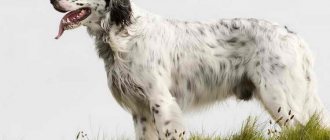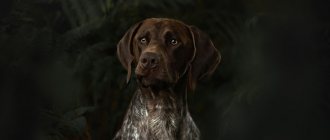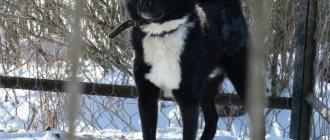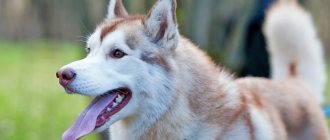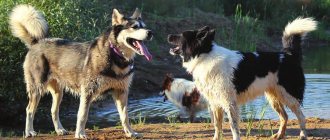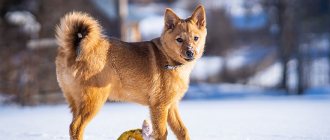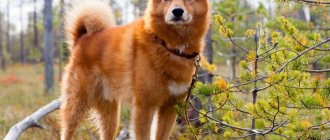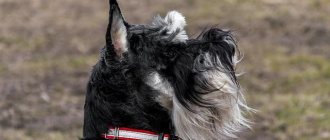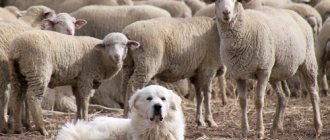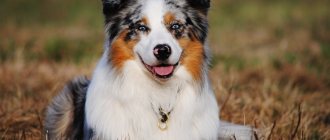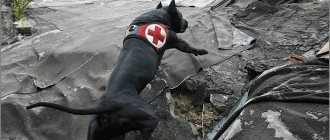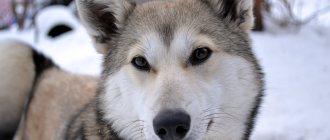History of the breed
Today, it is almost impossible to find reliable information about how this dog breed developed. Experts attribute this feature to the fact that in the northern conditions no one paid special attention to these dogs and did not specifically select them. Laikas lived next to people for many centuries, performing very important work, but at the same time they were not treated in any special way. Until recently, representatives of the breed were called “pointy-eared”, “northern” or “yard” dogs, but they became “likes” much later.
The oldest image of dogs was found on a fresco in a temple, whose construction dates back to the time of the existence of Ancient Kievan Rus, which means that the four-legged animals were somehow different from their own kind. Most likely this is due to the fact that in Western Europe hunting was a fun pastime, while in the northern regions and Siberia a person simply could not survive without such a trade.
The first breeding work with huskies was carried out by hunters: Poplavsky, Dmitrieva-Sulima and Shirinsky - Shikhmatov, and this happened in the last years of the 19th century. These people promoted the breed, classified huskies and built several large nurseries. From their trip to the northern lands they brought back the best representatives of pointy-eared dogs, which they purchased from the local population.
In 1925 of the 20th century, the first breed representatives were approved, which were brought to the First All-Union Exhibition, hence the popularity of huskies began. During the Great Patriotic War, northern dogs were used to walk in sleds, search for mines and perform other necessary functions. At the end of hostilities in our country, there were more than 60 nurseries of hunting dogs of various breeds, including huskies.
Breed standards were developed at the end of the 40s; they exist for a number of varieties of these four-legged animals.
Story
It is impossible to mention one of the many breeds of huskies without mentioning the others. They all come from the distant frosty north. Almost every Aboriginal tribe owned its own species of these animals, precious for Siberia. They accompanied people during the hunt, helped herd livestock, and protected them from attacks by predators. It is interesting that each tribe differed from the others in their way of life (they could be nomads or lead a sedentary life), habitat (on the plain or near the seashore), and in the method of obtaining food (hunting or fishing). Taking into account all these nuances of people’s lives, the stages of formation of the Laika breed that belonged to a particular people also changed.
It is thanks to such a variety of nationalities and the peculiarities of their way of life that we have the opportunity to choose among several varieties exactly the one that you like best.
The Karelo-Finnish husky is the reddest of all. It was bred in a factory with the participation of dog handlers from two countries.
Three Aboriginal families are involved in its origin. They were actively crossed with the Finnish Spitz in order to obtain a red coat. The breeders insisted on registering our heroes as a separate genus, but their similarity with Spitz dogs was so obvious that in 1984, at a meeting of dog breeders, it was decided to leave the Karelian-Finnish Laika as one of their branches of the Finnish Spitz genus.
The controversial issue strained relations between true and devoted fans of the Karelian-Finnish Laika and adherents of the Finnish Spitz. Attempts to register the breed in the USSR were unsuccessful. There were too many other problems in the country at that time, and there was no one and no time to deal with such issues. The International Canine Federation also refused to recognize our comrades, citing the fact that the name contained two separate states at once. In the end, everyone stuck to their own. There is still a group of enthusiasts engaged in breeding and improving the non-existent breed, without recognizing them as Spitz. And then there are everyone else who has difficulty distinguishing a red husky from a Finnish Spitz.
Description of the breed, character of the huskies
Today, there are quite a large number of sub-breed groups of huskies, we will talk about them a little later, but all dogs have common characteristics and external signs. The main feature is considered to be a love of hunting; the animals work well independently in conditions of freedom.
Devotion to the owner is combined with the love of freedom of these furry animals. They are distinguished by a soft and flexible character, but at the same time they will easily express their dissatisfaction if the owner treats the pet unfairly.
Dogs are very curious, which is also a typical trait of this breed. This feature should not be forgotten during walks, because a born hunter can easily run away a considerable distance, relying on his keen senses and catching up with his prey.
During a hunt, if the game is small (marten, squirrels), the dog crushes the victim and then carries it to the owner. Dogs detain larger animals and attract the owner's attention with loud barking.
The Laika will show aggressive behavior towards a person only when a dangerous situation arises. Representatives of this breed treat children very well. Keeping the situation under control, the hunter will react calmly to an outsider for the time being.
Northerners perceive the training process very positively, but they will not perform complex tricks to please a person. A potential owner should know that these dogs need to be trained and taught proper behavior from puppyhood.
East Siberian Laika
This breed is a hunting breed, it is multifunctional: it is capable of hunting both squirrels and deer. It is distinguished by a large, strong body; it is the largest among its brothers, reaching 53-65 cm . Hardened by frosts and the north, tireless in work. Like all Laikas, the breed belongs to the 5th group and 2nd section: Spitz and primitive type breeds, northern hunting dogs. Homeland - Russia. The dog was officially registered in 1949.
The animal has an elongated format, although most of its brethren are square. Strong paws, bones, and head help the dog survive in low temperatures, squally winds and hard work. The standard describes the following external characteristics of all huskies:
- The head is wide, massive, wedge-shaped with pronounced cheekbones;
- The muzzle is equal in length to the head, well filled, with strong jaws and a scissor bite;
- The eyes are medium-sized, oval, slanted, brown in color;
- The nose is large and fleshy, always black;
- The ears are erect, triangular, with a medium set;
- The body is long, muscular, with a straight top line, a tucked bottom line, pronounced withers, and an oval loin; The neck is long (equal to the length of the head);
- The tail is long, curved and carried over the back;
- The limbs are long, straight, parallel, with oval, collected paws;
- The coat is medium length, hard, straight, with a soft undercoat;
- Colors: black, white, piebald, black and tan, red, gray, brown.
For this breed, it is preferable to be kept in an enclosure or outdoors; if the range is free, then the animal should be on a soft long chain (prone to escape). The main criterion for proper care is long active walks and hunting. It is best to use such a pet for its intended purpose; it will not become a sofa pet.
A distinctive feature is thrifty eating habits. East Siberian huskies can eat to their heart's content because they are worried about the future feeding regime. This is convenient for avid hunters who can go into the forest for 2-3 days. Under normal conditions, this habit can cause the development of diseases.
The cost of the rare Siberian breed may surprise you because it is significantly lower than other exotic dogs. Without a pedigree, a puppy will cost 7,000-10,000 rubles , a pet-class or breeding class - 15,000 rubles , a show class - from 20,000 rubles . It is worth noting that the price for adult Laikas depends on their working qualities. A dog that hunts large animals will cost more than one that hunts small fur.
Breed standard
Each type of husky has its own breed standards. Here we will talk about what parameters the West Siberian variety should have. You can get acquainted with them in the table.
Breed standard and deviations
| Standard name | Norm (for males and females) | Vice |
| Dimensions | Males height at withers 55 – 62 cm Bitches height at withers 51-58 cm | Any deviation up or down |
| Suit | White, zone, gray, red, brown (any shade). White coat color allows for a brown nose | Black, black with white (not zonal), the appearance of specks on the body, head, paws does not match the main color.* |
| Wool | The guard hairs are straight and hard, there is an undercoat that is well developed and is soft and fluffy. | The presence of wavy and curly hair, excessive length, the presence of camber on the back, as well as dewlap on the tail.** |
| Skin, muscles, bones | The skin is dense, elastic, the muscles are well developed, the bones are strong | Any deviation from the norm |
| Head | It is wedge-shaped, the skull is moderately wide, the forehead meets the muzzle without sharpness, the muzzle should be sharp, long, but not narrow. Lips fit tightly, there are no drooping or jowls | The presence of a head of a raw and heavy type, there is a sharp steep transition from the frontal lobe to the muzzle, the muzzle itself is short and upturned |
| Ears | They have a high stance and the shape of elongated triangles, stand straight, the lobe is weakly defined | The presence of a round top, prominent earlobe*** |
| Eyes | Small in size, almond-shaped, dark brown or hazel in color, eyelids have a sharply oblique cut | Round eye shape, straight eyelids, color other than brown (white, yellow, green, etc.) heterochromia |
| Teeth, bite | White in color, large in size, should fit tightly to each other. Scissor bite | Deviation from the general provisions of the breed standard |
| Hind limbs | Good muscularity, good definition of angular articulations when viewed from the side | Pronounced straight rear, excessive closeness or spread of the hocks |
| Forelegs | Moderately oblique shoulder position, good muscularity, | Pronounced size, presence of clubfoot, straight shoulders |
| Tail | Bend into a steep ring on the back or side. It can be sickle-shaped, but it must touch the back. Straight reaches the hock joints or be 1-2 cm smaller, but not shorter | Tail shaped like a rod, plume or saber |
*huskies with brown and brindle colors are considered out of breed;
** Short-haired and long-haired dogs are considered out-of-breed;
*** the presence of drooping, semi-erect ears with drooping tops makes the dog out of breed.
Nutritional Features
The Norwegian Laika is one of the most undemanding hunting dog breeds to keep. This is explained by the way of life of Elkhounds, which has been formed over centuries, which is characterized by constant restriction of food. But this does not mean that the dog’s diet should be meager and primitive: constant poor nutrition has a negative effect on the health, working qualities, and appearance of the animal. What type of food - natural or ready-made industrial - to give preference to is decided by the dog owner, based on his capabilities.
Natural and dry food
If dry food is chosen as the main diet, it should not be lower than the “premium” class. The best choice for regular nutrition are ready-made diets of the “super premium” and “holistic” classes, which comprehensively take into account the age characteristics and physiological status of the dog. They do not contain synthetic components; in addition to the necessary nutrients, balanced in qualitative and quantitative composition, their formula includes vitamin and mineral supplements.
The debate about whether it is worth feeding a dog with industrial food has not subsided for many years. One way or another, after assessing all the pros and cons, the choice is made only by the owner of the animal. You can find out more about how to accustom your dog to dry food in our separate article.
In addition to the class of food, its labeling is important : during periods of heavy workload or competition, it is advisable to purchase food for the Elkhound with the inscription “Energy” on the packaging.
Royal Canin Energy
Blitz
Experienced breeders believe that natural food is preferable for dogs of aboriginal working breeds. In this case, the basis of the daily diet of an adult animal is:
- proteins - 400 g;
- complex carbohydrates - 350 g;
- animal fat - 15 g;
- fiber - 150-200 g.
It should be taken into account that the content of components must be adjusted depending on the time of year:
Norwegian Husky in winter
- in winter, to compensate for increased energy costs, the proportion of protein is increased and the amount of fiber is reduced;
- in the summer, when appetite is reduced, more sources of fiber are added to the dog’s menu - vegetables, berries, fruits.
It is recommended to finely chop all products intended for feeding the Elkhound: in this way, the prepared food is digested faster and better, and the dog will be able to be active almost immediately after eating. The volume of a single serving in normal mode should not exceed 3% of the weight of the dog itself.
Dogs playing in the yard
This average amount of food increases by about 1/3 when going hunting. In order for the pet to develop normal eating behavior, they resort to regimented feeding: an adult Norwegian husky is usually fed 2 times a day. Regardless of the type of diet chosen, clean water should always be available to the dog.
Types of huskies
Now it’s worth talking about the types of huskies that exist.
West Siberian
The height at the withers should be 55–62 cm for males and 51–58 cm for females.
Representatives of this group have average or above average height. They are distinguished by a strong and strong physique. According to the standard, the length of the body from the shoulder-scapula joint to the ischial tuberosities should not be much greater than the height at the withers.
West Siberian huskies have pronounced sexual dimorphism, males are larger than females and look more masculine. Both have well-developed muscles and strong skeletal bones.
Among the suits allowed according to the standard are the following:
- gray-zonal;
- red-zoned;
- gray;
- redhead;
- fawn;
- red-brown of any shade.
It is acceptable to have a white suit or piebald. On the white coat there are spots of any color than those listed in the list.
Russian-European Laikas
According to the standard, the height of males at the withers is 52 - 58 cm, females 48 - 54 cm. The dogs are medium in size, strong in build and have a square body. The length of the body can exceed the height at the withers. Representatives of the breed have strong bones and well-developed dry muscles. Just like the previous species, sexual dimorphism is developed.
Among the acceptable suits typical for the group:
- black with white;
- white with black;
- pure black;
- pure white.
East Siberian Laika
The height at the withers is 57–64 cm for males and 53–60 cm for females.
Representatives of the group are of medium size and have a compact but strong build. The head size is quite large. Males have stronger bones than females. Females, like males, have well-developed muscles.
Acceptable suits include:
- black with tan markings of red color;
- black;
- black with white;
- gray;
- redhead;
- brown;
- zonal;
- fawn;
- white;
- spotted with all the colors listed above.
According to the standard, the paws may have a small number of specks of the same color as the main color.
Representatives of the species are distinguished by a remarkable indicative reaction and an excellent sense of smell. Such a dog shows excellent hunting qualities, especially for large animals. The dog works best on its own. Laikas have a good disposition and are trusting of people.
Bear Karelian Laika
The standard established for males the height at the withers is 57 cm, for females 52 cm, a variation of 3 cm is allowed both in greater and lesser directions. In weight, males can reach 25–28 kg, females 17–20 kg. The dogs are medium in size and have a strong and robust build. The coat is thick.
Moose Norwegian Husky
According to the standard, a male must have a height at the withers of 52 cm, and a female 49 cm. The appearance is typical for all huskies. The body is compact and short, the cervical region is flexible and has the correct position. The coat is thick and abundant, but not harsh or too long. The tail is wrapped in a tight ring lying on the back.
Finnish Spitz (Finnish Laika)
The breed standard established the height at the withers for males is 47 cm, for females 42 cm. A deviation of 3 cm upwards and downwards is acceptable.
The height is below average, the body is square-shaped, while it is strong and dry. This variety is suitable for hunting birds of the grouse family, small predatory animals, waterfowl and elk.
general description
Laika is an unusually energetic dog that charges everyone who is near it with positivity. Probably, it is precisely this circumstance that has made the original northern dogs popular all over the world - they are increasingly used as companions, and not just as purely working dogs.
Appearance
Most huskies are of medium size; they are strong, very strong and hardy dogs. Few other breeds are able to withstand such physical stress and harsh temperature conditions. The husky has well-developed all senses, especially hearing and smell, and its exterior is maximally adapted to its work tasks:
- build - fit, close to a square, with superbly developed muscles;
- the head is wedge-shaped, with erect ears and a strong dental system;
- limbs - very strong, well muscled, with large but collected paws;
- The coat is thick and dense, with abundant undercoat and water-repellent properties; the length of the outer hair can vary.
The exterior of any husky can say a lot about its working qualities.
When carefully comparing huskies and huskies, the differences between these breeds are obvious. Huskies have a dense body and even a layer of fat, which helps the dog withstand severe frosts; huskies are leaner, but their fur is noticeably thicker. The husky's tail is saber-shaped, while the husky's is curled into a ring. And of course, huskies do not have those sky-blue eyes that huskies are famous for - only brown ones.
In the photo on the left is a husky, on the right is an East Siberian husky; the difference is obvious
Character and behavior
Over the course of many centuries of almost natural selection, the husky has developed the main breed quality - a very high focus on people. Dogs never lose sight of their owner, they literally catch his desires and try to predict them.
Such a dog will never get lost, carried away by the chase, either in the forest while hunting, or in a noisy city while walking - a partnership with a person for a husky is much more important than the momentary excitement of the hunt.
Whatever the husky is doing, she will find time, strength and tenderness to communicate with the child.
Of all family members, huskies especially single out children and take them under their wing. For the most part, a variety of domestic animals are treated tolerantly - with the exception of breeds with a pronounced hunting instinct.
Diseases and life expectancy
Good health and an excellent immune system are the undoubted advantages of all huskies. For working lines, genetic diseases are not typical at all - the main problems of such dogs are various injuries received “during performance”. But working dogs live shorter lives than pets: they are often treated utilitarianly, and their lifespan is limited to their service life, which rarely exceeds nine years. And companion huskies, if kept in decent conditions, can live 12–15 years, in some cases even longer.
Pros and cons of the breed
Like all other dogs, huskies have their positive and negative sides, which you can get acquainted with in the following table.
Advantages and disadvantages
| pros | Minuses |
| Balanced psyche | Time for coat change. During this period, dogs acquire a not very attractive appearance. Tufts of thick fur will be scattered throughout the house. Pets need to be brushed at least once a week. Frequent washing of huskies is not recommended. Dogs have a thick undercoat that is very difficult to get wet and equally difficult to dry. Against this background, skin irritations may develop in huskies. Dry shampoos or foams are used for wool |
| No aggressive behavior towards people | High risk of infection. While hunting, huskies spend a lot of time in the lap of nature (forests, meadows, etc.) This is where dogs are exposed to insect bites and can pick up ticks or fleas with all the ensuing consequences. It is necessary to strictly adhere to the schedule of vaccinations and deworming |
| Active energetic behavior | Dogs often suffer from plaque and tartar, which leads to various oral diseases |
| Amenability | Manifestation of waywardness |
| Smartness | Apartment keeping is not recommended due to the overly active nature of the dogs. |
| Excellent performance even in harsh conditions. The dog can participate in hunting for several days and will not need complementary feeding. | The need for long daily walks |
| Unpretentiousness in the diet. It is enough to give simple food from porridge, fish products, vegetables and do without delicacies | |
| Quick adaptation to living conditions | |
| Ability to learn | |
| Friendly character allowing huskies to get along with both children and other members of the animal family | |
| The ability to navigate in space, excellent hunting qualities combined with excellent vision, hearing and smell | |
| Infinitely loyal to their owner |
Features of keeping and caring for Laika
All Laikas are active, energetic, and need a lot of space. Apartment housing is only suitable for small breeds, but this is only possible with long walks and training. These dogs get along best in a free enclosure or in a fenced local area.
It is important to choose the right climate. These animals are not afraid of frosts and blizzards, but the heat can be destructive. Therefore, in warm southern countries it is not recommended to have Laikas.
In general, the breed is unpretentious. Laikas are omnivores and do not require constant attention and care. Dogs are original, they are used to working for long periods of time, going hungry, and looking for food on their own. But to improve the pet’s quality of life, it is worth following the feeding regimen, vaccination and walking schedule.
You need to purchase a comfortable lounger or mattress, and equip an enclosure or booth. Usually Laika is kept on a soft long chain. There must be a canopy where the animal can shelter from bad weather.
Important article on the topic: “Everything you need to know about dog vaccinations.”
Features of character and behavior
All Laek representatives are similar in character. These are freedom-loving northern dogs who are accustomed to serving people faithfully. They are all good hunters, have enough strength, endurance, a sharp mind and training abilities.
But the negative traits of the breeds are also similar. In most cases, they manifest themselves in stubbornness and a desire for dominance.
Advantages and disadvantages
- First of all, the breeds are valued for their amazing physical capabilities . Any husky can be considered a first-class athlete and hunter. They have developed sense of smell, hearing and vision; high survival rate, resistance to cold climates, and performance are noted. In addition, dogs are considered healthy and have strong immunity.
- These animals are balanced, calm, and friendly, which is why they often cannot serve as guards . They are used to living side by side with humans, so they do not experience aggression or anger. They get along easily with children and love to play with them.
- Excellent training acquisition rates . Laikas are very smart, quickly grasp, and easily cope with commands. They are active and energetic, quickly master agility, love to run with their owner and play sports.
Among the shortcomings of the breed are stubbornness, love of freedom, and often disobedience. Without proper training, a dog can become uncontrollable.
Laikas love to chew and damage furniture and household items. They are in dire need of physical activity, although otherwise they are unpretentious.
Nutrition
Laikas are completely unpretentious. They are not gluttonous and can go without food for a long time. Adult pets are usually fed 2 times a day, puppies - 4-5 times . The serving size depends on the activity of the animal. Street dogs need more food. The portion is also increased in the cold season.
Like all pets, Laika can be fed with both dry and natural food. If the owner chooses the first option, then grain-free products for medium active breeds with a high protein content are suitable.
We recommend that you read a detailed article on the topic: “How and what to feed a dog: types and characteristics of nutrition.”
Natural nutrition should consist of 50% protein foods:
- Meat;
- Boiled sea fish without bones;
- Dairy products;
- Eggs.
The pet also needs cereals: cereals boiled in broth or water. From puppyhood, the animal should be given vegetables and fruits low in starch.
Dogs should not be fed from the owner's table, nor should they be given bones, flour and confectionery products, fatty, fried, salted and smoked foods.
Walk
These dogs, like no other, need active long walks and training.
- Even if an animal is kept in an enclosure or on the street, it needs to go out into plantings, forests, and park areas to run around, burn off energy, and hunt.
- The best pastime for Laikas is what is provided genetically: for sled dogs - running in a harness, for shepherds - grazing livestock, for hunters - hunting.
- It is recommended to keep these dogs on a leash at all times, especially in crowded places. Due to their strong instincts, they are prone to running after game, cats and small rodents.
- Apartment pets need regular walks two or three times a day for 1.5-2 hours. At first, puppies are walked more often, but for 30-40 minutes.
Grooming
- coat care is needed, especially during seasonal shedding. brush your dog 2-3 times a week using slicker brushes and long-toothed brushes.
- are bathed 2-3 times a year; they can be wiped with snow or watered with a hose.
- In the summer, Laikas are cut , but this procedure is contraindicated for show animals.
- Ears, eyes and teeth are examined every week. Clean when dirty.
- The claws of these pets grind down without human intervention, but if they grow too long, they can be trimmed with a nail clipper.
During the summer, pets need to be treated for fleas and ticks. Also, do not forget about deworming (cleansing from worms), which is carried out once every 2 months.
Training
The character of Laikas can be complex, it is very difficult to curb their temperament, so not everyone can cope with upbringing and training. Such a dog can only be entrusted to a professional or experienced hunter. In order for a husky to obey, the owner must be strict and firm. But respect for your pet is the key to a long, good relationship. The pet will not tolerate rough treatment or insults.
By 3-4 months, the puppy should know its daily routine, nickname and primary rules of behavior . Socialization can begin after the second vaccination. This is important so that the dog learns to control its emotions and respect other people and pets.
Read about how to properly train a dog in the article: “Training a puppy: effective methods from dog handlers, learning commands at home.”
To adapt to hunting, animals must be sent to special canine institutions, or allowed to be handled by specially trained people.
All groups of Laikas and individual breeds are similar in appearance and temperament. You can choose a specific one based on function, color or size. In general, all species are friendly, active, loyal and good hunters.
Maintenance, care
The thick fur of huskies allows the animals to feel great in low temperatures. It will not be difficult for them to settle down to sleep right in a snowdrift. But in hot climates, representatives of this breed are extremely uncomfortable. It is recommended that such a dog be kept outdoors rather than indoors.
Laikas are very active animals, and therefore they need to be walked for a long time every day and at the same time given physical activity.
When walking, it is best to choose an open space located as far as possible from the highway. If there are no such places, then the pet needs to be walked without letting it off the leash.
Representatives of this breed are distinguished by cleanliness, but frequent washing is contraindicated for them due to the thickness of the undercoat, which dries very poorly. To take care of the coat, the owner needs to comb his pet several times a week and use dry shampoos.
Feeding
After a husky puppy appears in the house, the owner’s first need is to provide the animal with daily nutrition. Here you can use both specialized (store-bought feed) and natural products. It is strictly forbidden to mix both of these options.
The growth and development of a dog depends on the diversity of its diet, especially in the early stages of life, when skeletal bones, muscles, etc. are being formed.
Worth knowing! Until six months of age, the puppy should eat 5 to 6 times; after the 6th month, reduce the number of meals to 3 to 4 times a day.
Adult animals should receive food twice a day, in the morning and evening. It is important to remember that the dog should always have a bowl of clean drinking water available to him.
The natural diet is represented by boiled or steamed food. The permitted products include the following:
- beef;
- pork;
- rabbit meat;
- bird;
- fish;
- milk products;
- occasionally raw eggs;
- vegetable crops.
There are some types of food that you should absolutely not give to huskies. This includes not only smoked, fried, salted and spicy foods, but also the following:
- pea grain;
- potato;
- wheat bread;
- sweets in any form;
- pasta.
A dog’s health and life expectancy depend on a high-quality diet. If you follow all feeding standards and properly care for your husky, it will live for about 10–15 years.
Upbringing
Before you bring the puppy home, you need to choose a place where he will sleep and eat, they must be strictly defined. A potential owner should remember that the puppy will go to the toilet after feeding and after waking up. To avoid further problems, the puppy must be taken outside on time, where he will relieve his natural needs. The main thing in this matter is perseverance and perseverance, only then the pet will begin to understand what it must do. By the age of two months, a husky puppy should have a clear idea of where its place is, where feeding occurs, obey the command “come to me” and have the correct reaction to the sound of a whistle, which will replace the voice command during the hunt.
Continuation of the reinforcement of this command and the call signs of the whistle must be reinforced after the puppy turns three months old during full walks. At this point, it is necessary to begin training the main commands. By 4 months of age, properly trained young dogs are mostly effortless and can do all of the above.
To stimulate obedience, it is important not to forget to praise the dog and give it its favorite treat, which the husky will appreciate.
When raising a puppy, the owner must show persistence and firmness, but there should not be excessive cruelty. You need to know all the inclinations and characteristics of your pet in order to use them to develop the necessary skills in the animal. If there are harmful tendencies, then they must be nipped in the bud, otherwise they will later become habits that will be very difficult to get rid of. The laying of the foundations of education for this breed continues until the age of one.
Care and conditions of detention
Thanks to their fur, huskies can withstand low temperatures well and are able to sleep even in snowdrifts.
They do not tolerate heat well, so it is more comfortable for them to live on the street than in an apartment. In addition, they are active and need daily long walks with mandatory exercises.
It is advisable to walk your husky away from the roadway, in an open space. If this is not possible, then the dog must be on a leash.
Laikas are clean, so you should bathe them only when absolutely necessary. Several times a week it is necessary to comb your pet's fur and inspect it for ticks.
The animal is unpretentious when it comes to food, but this does not mean that it needs to be fed from a common table. Huskies should receive a balanced diet containing the necessary nutrients, or eat natural products.
In the latter case, the range of products should be varied - meat, fish (river), dairy products, cereals, vegetables. It would be a good idea to add nutritional mineral supplements.
It is enough to feed an adult husky once or twice a day.
With proper care, the husky lives from 10 to 14 years. There are cases where dogs lived up to 17-18 years.
The main condition for a pet’s long life is the love of its owners, walks, and good nutrition.
Puppies
Most often, this breed is purchased for hunting, and there are a number of features that can help you choose a good working dog.
Choosing a puppy
You cannot do without an external examination of your future pet; a healthy puppy must meet the following requirements:
- active behavior – attempts at long runs, quick ability to find yourself in a sitting position;
- eyes and ears should be clean, the same applies to the skin on the abdomen. The presence of an umbilical hernia is already a bad sign;
- lack of aggressive behavior is unacceptable for a hunting dog;
- calm and independent character.
It is worth paying attention to gender. Males are larger in size and have some aggression in their character, and therefore such a dog will have to be dealt with more seriously. This husky is suitable for hunting large animals (boars, moose, bears). Among the disadvantages are the clarifications that arise between dogs during a hunt.
Bitches are somewhat smaller in size, but they are considered more resilient compared to representatives of the opposite sex. They are easier to train, and their character is more flexible. They are distinguished by universal use in hunting from small animals to large ones. Relative disadvantages include sexual hunting, whelping and caring for offspring.
History of the origin of the species
This breed is considered native for a reason. Dogs have lived near humans for thousands of years. Perhaps these animals are the closest relatives of domesticated wolves and jackals. The first evidence of the existence of Laikas is found on the territory of ancient Rus'. The oldest fresco depicting furry pets dates back to the 11th century.
Read the detailed article: “How to distinguish a Laika from a Husky: characteristics of the breeds.”
These animals not only served the northern peoples, but also helped the Western European nobility in hunting. Rich people loved to go into the forests to hunt bears and wild boars; Laika coped with their baiting remarkably well. An interesting fact is that all representatives of this group are called Spitz abroad.
Selection and mixing of blood in the north was not particularly followed. Working qualities were distributed equally across all newly emerging breeds . The official description of these animals appeared only in the 19th century. Just at this time, work begins on classifying and improving the qualities of the breed. The participation of Prince Shirinsky-Shikhmatov and dog handlers: Poplavsky and Dmitrieva-Sulima is considered important.
There are 3 main types of Laikas: sledding, herding and hunting:
- The first group is considered the most numerous, in terms of the number of species included in it. This includes draft dogs, which are especially popular in the north.
- The second subspecies includes those Laikas who protect livestock from wolves and bears.
- Hunting dogs still perform their functions and are considered indispensable in northern European regions.
Price
Before buying a dog, a potential owner must understand why he needs a husky in the first place. If you need a working or guard dog, you can purchase a puppy without documentation, but it must have working parents. Here, representatives of the breed may have some flaws in appearance, but they will have the required skills. Pets with documents will be needed for breeding and exhibitions.
- Russian-European huskies from working parents in the absence of a pedigree will cost in the range of 2,000 – 10,000 rubles. When preparing documents, the price increases to 10,000 - 40,000 rubles.
- East Siberian puppies 4000 - 5000 in the absence of documents, in them 10000 - 20000.
- The remaining varieties cost 3,000 – 5,000 rubles without pedigrees; its registration increases the cost at least twice.
West Siberian
This breed is the most numerous, in terms of the number of heads, and the most common among hunters. It is distinguished by its predatory appearance; it is more like a wolf in color and temperament than others. Not large in size - 52-60 cm at the withers, with a weight of 16-22 kg . Externally a strong animal, elongated format. It is considered a universal hunting dog.
Country of origin: USSR (Russia). The breed received recognition in 1980 and is officially registered by the International Canine Organization.
In proportions and appearance it is not much different from the East Siberian. A special feature can be considered deep-set, sharply slanted eyes and a predatory gaze. Preferred colors : white, piebald, brown, gray, red.
The breed does not cause any difficulties in caring for. West Siberian huskies are unpretentious. They can go for a long time without water and food, work hard, and hunt. Such dogs need space; living in an apartment will negatively affect their well-being. In order for a pet to live on the street, it needs to be equipped with an enclosure or a booth with a soft chain. It is important to regularly go hunting with your animal or just for walks in the forest.
Read a detailed article about the breed: “The West Siberian Laika is an excellent hunter and a cheerful companion.”
A puppy without a pedigree can be purchased for 3,000-5,000 rubles , a pet-class or breed-class for 15,000-20,000 rubles , a show class dog for 25,000 rubles .
Owner reviews
Most owners praise their pets very much, but do not forget to mention that the dogs are very energetic and therefore need long walks. Some people talk about the willful nature of huskies, which is not so easy to deal with. Still others say that a number of problems are caused by caring for a pet during shedding.
As a conclusion, I would like to remind potential owners that huskies are dogs that need to be constantly exercised. These are working dogs, not fluffy pet toys; if you do not load your pet with the loads it needs, then it will find entertainment for itself, which the owner may not like at all.
Riding huskies
The main purpose of sledding huskies is to transport goods and people in polar conditions. These include:
- Greenland dog;
- Canadian Eskimo dog;
- Samoyed;
- Sakhalin Husky;
- Swedish White Elkhound;
- Yakut Laika.
Some species of polar huskies are also used for hunting, but are not used as guards due to their increased friendliness to people. Animals of this species have a well-expressed sense of smell and ability to navigate.
Greenland dog
The breed is also known as the Greenland Husky. The name of the animal indicates that its homeland is Greenland. It is one of the oldest breeds of sled dogs.
Previously, the animal was used to hunt seals, reindeer and bears.
Source: petstory.ru
These are very strong and quite large dogs: height at the withers reaches 55-60 cm, weight on average is 30 kg. Any coat color other than pure white is acceptable for the breed.
What a Greenland Laika dog looks like is shown in the photo above.
Canadian Eskimo dog
The Kimmik or Eskimo Husky is a rare purebred dog breed in Canada. Genetically identical to the Greenland dog.
The height of adult individuals reaches 50-70 cm at the withers, the weight of large males reaches 40 kg.
Preferred coat colors: white, dark red, brown, gray.
Unlike typical huskies, kimmikis cannot bark. When they give voice they howl like wolves. The latter have long been mistakenly considered to be their distant relatives.
Eskimo huskies have a more submissive nature compared to other representatives of the Spitz group. They are easy to train and have good endurance.
Due to its genetic characteristics, the breed needs regular intense exercise, such as karting or skijoring.
Currently, the Kimmiki are endangered. At the moment there are several hundred individuals in total.
Samoyed
The breed is undeservedly assigned to the group of sled dogs. Samoyeds are unique in their kind. They have herding and guard qualities. They make excellent companions and nannies for small children. Samoyeds are not aggressive and get along easily with other pets.
The height of adult individuals reaches 50-60 cm at the withers. Samoyeds weigh up to 30 kg. Colors allowed by the standard: snow-white, cream, white with fawn admixtures.
Sakhalin Husky
Sakhalin huskies are on the verge of extinction. Currently, dog handlers are working to restore their population.
The animal's country of origin is considered to be Japan. In its homeland, the dog is called Karafuto-ken, which translated into Russian sounds like a Sakhalin dog. Also known as the Gilyak sled dog.
The largest adult animals reach 62 cm at the withers, rarely - 70 cm. Body weight can reach up to 40 kg.
Representatives of the breed come in the following colors: white, black, red, brindle, gray.
The Sakhalin Husky was used not only as a sled dog, but also for baiting bears, and also as an assistant in catching sea game.
Yakut Laika
Belongs to the category of multifunctional dogs that can be used both for riding and as hunters of fur-bearing and ungulate animals.
Animals grow at the withers to 53-59 cm, and gain weight from 23 to 30 kg.
The breed accepts any spotted colors in combination with white, as well as solid colors, except pure white.
The dogs are good for hunting arctic fox, bear, seal and geese. However, their main purpose is transportation.
The animals are completely devoid of aggressiveness, so they are not suitable as guards. The only thing these dogs can do is warn the owner with their voice about the arrival of a stranger.
Dog appearance (standards)
Naturally, each type of husky has its own breed characteristics. But still there are common features inherent in all.
Dimensions
The average height of males is 52-58 cm. Females usually have a shorter height, from 48 to 54 cm. The maximum height limit is 63 cm.
The weight of the animal is from 18 to 30 kg. Females weigh less than males.
Wool
Laikas have straight fur. It is quite thick and has a dense undercoat. The length is average. On the neck the hair is slightly longer, here it forms a specific collar.
Colors
The predominant colors are: white-gray, grey, black, tri-color, piebald.
The red color is undesirable, as during a hunt the dog can be confused with a fox.
Head
The animal's head has the shape of a wedge-shaped oval.
A husky's ears should always be erect!
Teeth and jaws
The animal has a scissor bite. The teeth are white and very strong.
Eyes
The eyes of a husky dog are round. Placed a little askew. The predominant color is brown.
Body and limbs
This dog is very muscular and has a strong build. The body is stretched. The animal's paws are straight. The hind legs are muscular, while the front legs are drier. Laika has a proud posture.
Tail
The animal's tail must be bent into a ring.
Rock defects
Any deviation from the accepted standard is considered a defect.
Video about the breed
When planning to get a dog, it is imperative to weigh the pros and cons, familiarize yourself with the characteristics of the breed and clarify the features of its maintenance. And Laika is no exception. After all, by getting a dog, its owner takes responsibility for the animal, himself and his family, as well as for those around him who will come into contact with this dog. Therefore, before getting a pet, the owner should decide whether he can give his dog the attention it deserves or not. But everything is more than compensated for - the husky is not only a good hunter, but also a reliable companion for its owner.
Education and training
You need to raise a puppy from a young age. If the animal is in a house or apartment, it must immediately be accustomed to the toilet and the place where it will sleep. Stop your puppy from trying to sleep in the bed or on the couch and ruin things.
There is an opinion that dogs of this breed are difficult to train. These dogs are very smart and think quickly, but they don't always like to learn. No, animals are not lazy or stupid, they just have a well-developed sense of self-esteem. To train them, you will have to spend a little more time.
Alternate the training process with games! Use rewards in the form of treats.
There is no need to raise your voice at your pet, because he will take it as an insult.
Never physically punish your husky.
This will only lead to a negative result: the dog will begin to harbor resentment and anger, which in the future may result in open aggression.
Be kind and patient, and these qualities will definitely help you raise your pet as a loyal friend and reliable protector for the whole family.
Health and illness
Artificial selection, which northern hunters have carried out for centuries, has made the husky one of the healthiest breeds. Therefore, there are no diseases characteristic of this breed and it is very resistant to viruses. But given her nature, the likelihood of injury and fractures is quite high.
Regular walks are mandatory, otherwise the dog may become depressed. If the dog does not follow the correct daily diet, or does not lead an active lifestyle, then there is a possibility of developing a number of ailments related to digestion, kidneys, eyes, ears, and joints.
Lifespan
The lifespan of a husky is 14–16 years. However, this period can very easily be shortened with poor nutrition and improper care for the dog.
Purpose of huskies
The amazing hunting instincts of northern dogs are genetically determined. The dog's goal is to track and bark at game. She must indicate the location of the beast, distract her from the hunter.
Dogs have an excellent sense of smell and a loud bark; they can track animals even after 12 hours; they also work in a team, for example, to hunt a bear.
The pet shows its best hunting skills:
- for small game - quickly finds and bites the neck, but does not damage the skin;
- on a squirrel or sable - covers vast territories and informs the hunter with a loud bark;
- on a capercaillie or hazel grouse - it almost sneaks, and when it gets close, it barks, indicating the place of the bird;
- for waterfowl - the dog walks alongside, carefully sniffs the scent of the bird, after shooting, rushes into the water and delivers it to the owner;
- at a bear - first it barks when the predator tries to leave, bites painfully on the legs, showing miracles of resourcefulness and speed of reaction.
Character and intelligence
The Laika dog is a freedom-loving, independent and devoted animal. Her curiosity knows no bounds, so walking without a leash will be very risky - she can run far from her owner. The dog does not tolerate loneliness, and it is difficult to bear separation from loved ones. She loves her owner very much, and he always remains a leader for her.
The passion for hunting is in the husky's blood - this is facilitated by sufficient strength, endurance and a sharp mind.
Attitude towards children and others
Laikas ignore others and get along well with children - they play, run, and jump. They can show aggression when they feel the owner is in danger.
Training and education
A negative trait of the breed is stubbornness and desire for dominance. Therefore, they hate training, and learning can be difficult.
It is logical that learning commands should begin from childhood. Moreover, you don’t need to expect complicated tricks from this breed. You can devote an enormous amount of time to training huskies.
Don't forget the basics when working with a dog:
- The dog serves the owner, not the owner the dog.
- The dog drives the animal, and the man hunts it - and not otherwise.
- Before a walk or hunt, the animal must be left hungry.
Basic commands are taught to a dog from one and a half months to one and a half years. These include 5 commands - sit, stand, no, near me, next to me. These commands are taught at home in a relaxed environment.
Basic rules of training:
- It is strictly forbidden to hit or shout at the puppy.
- When following a command, the puppy must be praised.
- If the puppy shows complete apathy towards training, there is no need to continue it. You need to let him rest for a few days.
A properly raised husky is a loyal friend and protector of the whole family.
Character of the Russian-European Laika
The Russian-European Laika is a dog in love with its owner, and at the same time with all his associates, from family members to friends. Representatives of this family, in principle, are not prone to aggression towards humans, and when it comes to children, huskies immediately turn into the most good-natured and forgiving creatures in the Universe. The breed's territorial instinct is very moderately developed, so its representatives make mediocre watchmen. However, some breeders specifically cultivate protective qualities in their charges. Such individuals are noticeably more suspicious than their relatives and are no longer so loyal to strangers. If you need a dog that can be involved not only in hunting, but also in a simplified version of the ZKS (protective guard service), look for a seller who specializes in breeding guard huskies.
The main weapon in the fight against suspicious guests, available in the arsenal of every Russian-European husky, is a loud bark. By the way, about the “vocal abilities” of the breed: REL are happy to raise their voice with or without reason, and especially piercing concerts are staged by bored individuals. Accordingly, if you keep a Russian-European Laika in your apartment and are often away on business, get ready to ruin your relationship with your neighbors, who are forced to be unwitting listeners to your pet’s musical exercises.
The patience of Russian-European Laikas has become something of a legend, so a properly trained dog will always allow its owner to pull a bowl of food out from under its nose and will suppress any counter-protest. At the same time, dogs react sharply to unfair punishments, so before you slap a dog on the nose with a newspaper, think carefully about whether the pet deserves such treatment. Also consider the exercise needs of the breed. If the Russian-European Laika does not go hunting for a long time and at the same time lives in the house, destruction of the interior is inevitable. And the point here is not in the obstinate nature of the relics, but in natural instincts that do not find application in everyday life.
How to choose a husky puppy
Laika puppies are selected based on priorities. First you need to decide whether you need a pet for your soul or whether it must be a purebred puppy for hunting. If you are not going to hunt, take the baby you like. In the second case, it is necessary to more carefully study the baby’s pedigree and find out his parents.
It is advisable to buy a baby from a nursery. Usually good breeders have their own websites on the Internet. Without leaving home, you can choose a baby, look at photos of mom and dad, and look at each pet. If age allows, you can buy the baby right away; if he is still small, then the animal can be reserved.
Do not take an adult animal. Laikas become very attached to their owner and remain faithful to him until the end of their lives.
When meeting in person, pay attention to the puppy’s appearance: he should be cheerful, healthy and well-groomed. Be sure to ask the breeder any questions you have.
Diet of huskies
The nutrition of the husky must be approached with the utmost seriousness, since the life expectancy of the tailed pet completely depends on it.
Natural nutrition
A properly balanced natural diet for a husky should include the following components:
- Boiled beef should make up 30–50% of the nutritional diet. It is not recommended to feed raw meat to prevent worms from appearing.
- Sometimes it is useful to include fish in your diet. This component will help strengthen the skeleton. The fish should also be boiled.
- Cottage cheese, nuts and dried fruits are necessary to prevent the occurrence of diseases associated with teeth and skeleton. All these products contain a lot of calcium.
- Cereals - buckwheat, egg, pearl barley, rice, oatmeal - should make up approximately 20-30% of the total diet.
- Vegetables and fruits - in particular, carrots or cabbage. They must be given raw. Sometimes garlic is added to food to prevent worms. Vegetables and fruits contain vitamins that your dog needs.
All large components must be crushed and mixed with the rest of the food.
It is necessary to make sure that the dog always has fresh water. It is recommended to change it twice a day.
It is prohibited to use sweets, flour and smoked foods, and spices in the dog’s diet.
Milk, kefir and fermented baked milk can cause obesity and diseases of the dairy tract, impair vision and lead to loss of smell. They can only be given to puppies under 4 months of age.
Dry food
It is not customary to give dry food to dogs - they can negatively affect the dog’s liver and kidneys. This type of food is convenient to use in minimal quantities for reward during the training process. It is not allowed to use dry and natural food at the same time.
Vitamins and supplements
It is recommended that huskies be given raw bones to chew on. In this case, in addition to teeth training, the dog receives some nutrients and vitamins.
It is considered mandatory to add vitamins to food. It would be right if they were prescribed by a veterinarian.
Contents of the Norwegian Husky
The Norwegian Elkhound is an active dog with a lively, inquisitive character. Limiting the area where the husky is forced to move little has a negative impact on its health and working qualities. Therefore, it is highly not recommended to keep a Norwegian Elkhound in a city apartment. The best option for providing living space for a pet is to set up an enclosure with a booth on a spacious fenced-in plot.
In the fenced space of the enclosure it is easy to control the safety of puppies
Growing young animals and adults should not be kept on a leash. The Norwegian Laika is one of those breeds in which a sharp restriction of freedom provokes the development of various diseases and degeneration, ending in the inability for long, hard hunting work, and the loss of the most valuable hunting instincts.
A practical option for arranging an enclosure with a walk
This breed is not suitable for homebodies either: even if kept outdoors, the Elkhound needs two to three hour daily walks. This is especially important for dogs over three years of age in order to prevent obesity and metabolic disorders.
